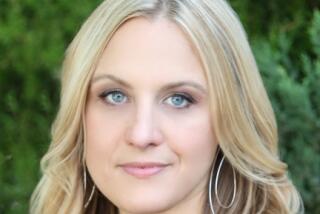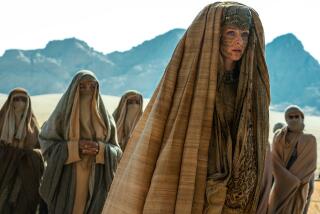Review: ‘Handmaid’s Tale’ sequel ‘The Testaments’ puts Margaret Atwood’s powers on full display
In “The Testaments,” the long-anticipated sequel to “The Handmaid’s Tale,” Margaret Atwood’s powers are on full display.
The theocracy of Gilead, in which powerful men have used the Bible as genesis and justification for death, torture and banishment, has banned reading. So when a young girl is finally allowed access to the Bible, and realizes that the verses and stories she has been read by her father and teachers are not the same as those on the pages, her very soul is shaken.
That girl is Agnes Jemima, privileged daughter of a Commander. “Our Bibles were kept locked up, as elsewhere in Gilead: only those of strong mind and steadfast character could be trusted with them, and that ruled out women, except for the Aunts.”
Agnes realizes that her life has been full of lies, that she might lose faith. “If you’ve never had a faith, you will not understand what that means .… You feel exiled, as if you are lost in a dark wood.” This is her testimony, recorded years later for posterity.
Readers of “The Handmaid’s Tale” will recognize the Aunts, the women who trained Handmaids as vessels for sex, beating girls on feet and hands because those body parts were not necessary for their task: to bear children to men whose wives cannot.
Atwood’s new novel is all about narrative, the written and recorded testimonies of three women: Aunt Lydia, a terrifying and punitive woman, writes her foundation story now, with hoarded ink, pages hidden in a Catholic historical tome. Agnes, at 14, is betrothed to an even more powerful Commander. Daisy, a teenager raised in Canada whose parents are killed by Gilead terrorists, comes to learn her own connections to the poisonous regime in the United States.
Their testaments begin 15 years after the beginning of civil war.
The Commanders, with their blue-robed Wives, red-robed Handmaids, and green-robed Martha housekeepers, retain power in Cambridge, Mass., heart of Gilead. The most-prized humans are children, and yet what happens to daughters is no gift.
Illicit sex, of course, in this republic founded on sexual control, leads to the complicated, fascinating plot of “The Testaments,” just as illegal sex and forbidden Scrabble led to the downfall of another Commander in “The Handmaid’s Tale.”
Offred, narrator of the first novel, attempted escape into the woods toward Canada, her husband presumed shot dead by Guardians, her young daughter torn from her arms. Offred’s lyrical, precise voice gave readers the shocking limits of her existence, in a small bedroom, on sidewalks where she saw humans hanged from the Wall, bloody mouths pressing through white hoods, and inside those walls, the Eyes and the Aunts, like Lydia, ruled over the republic.
In the new novel, we learn that Lydia’s life as a family court judge ended in a single day. Hundreds of professional women — doctors, lawyers, business owners, professors — are herded at gunpoint into the Harvard football stadium, many killed by firing squad, others recruited to shoot.
“The opposition is led by the educated, so the educated are the first to be eliminated,” Lydia recounts. “But none of my college-acquired polish was of any use to me here. I needed to revert to the mulish underclass child, the determined drudge, the brainy overachiever .… I needed to work the angles, once I could find out what the angles were.”
Chosen by Commander Judd, Aunt Lydia is tortured first, and then placed into position as the founder of the framework of life for women here. She secures power by insisting that only women will control other women; men are not even allowed into Ardua Hall, where only Aunts and Supplicants reside. From Ardua, she rules what she can and plots retribution with infinite patience, waiting for the right girls.
The right girls are Agnes Jemima and her best friend Becka, who are to be child brides. Both have been traumatized by a sexual predator, a man whose profession allows him unlimited access to young girls. (The parallels to present-day stories we women are finally telling are strong.)
Recruited by Aunt Lydia, they become Supplicants, finally taught to read and write. After Agnes opens that Bible, the truths multiply. Her dead mother was not her mother; her hateful stepmother reveals that her birth was to a treacherous Handmaid. Agnes is betrothed to Commander Judd, an original Son of Jacob who began Gilead. In his 60s, clearly sterile, he has poisoned three Wives already, had five Handmaids, and desires only child brides.
The “fairy tale” is what I thought of: Bluebeard, Sleeping Beauty, yes, but also men today who call wives “Mother,” rather than their “Christian names,” men who refuse to be alone with reporters or other professional women, men who have been married three times and yet court evangelical support.
We see Particicutions, which Aunt Lydia began, wherein men are killed violently by hand, by Handmaids. Endless suicides, women who drown themselves in cisterns, hang themselves by doorknobs: Atwood, perhaps in homage to a Puritan ancestor who was hanged for a witch, pays particular attention to the primitive nature of hanging.
Daisy is the secret child, transported from Canada to Gilead, as in a fairy tale wherein a baby must be hidden. These woods are dark, with clues for readers of the first novel in the trees. Agnes Jemima remembers forests, and running, and a woman’s arms. Daisy, asked whether she knows Gilead, says, “I watch the news. We took it in school,” but she’s trained in safe houses set up by Mayday, the rebels.
Atwood’s braided storyline leads to the best parts of the novel, the conversations between girls and women. The Aunts are named for remembered beauty mavens — Estee, Helena, Elizabeth, and even Vidala. (Think hair, for the last one.) The wedding arranger Aunts are Sara, Lorna and Betty.
But cloistered lives encourage betrayal. Writing these stories in her private sanctum, alongside her forbidden favorite novels (“Jane Eyre,” “Anna Karenina,” “Lives of Girls and Women”), Lydia plans the downfall of the republic.
I confess: I didn’t read the first novel in the 1980s; as a young married woman surrounded by babies and family, the first chapter was too frightening. I read “The Handmaid’s Tale” last month. Having three college-educated daughters with brown skin and curly hair, I was chilled.
But in both novels, brief mentions of Children of Ham being taken from Detroit to Homelands in North Dakota, of Mormon rebellions in Utah and the independent Republic of Texas, among other scattered asides, didn’t seem reflective of the U.S. as a nation where nearly half the population is descended from indigenous, immigrant and formerly enslaved people of color; where people speak Spanish, Yoruba, Tagalog and Mandarin.
Lydia, as a former family court judge, might have given readers a bigger sense of how Gilead’s founders sought a return to whiteness, especially when some current politicians explicitly cite a need for “American babies.” In 1986, some reviewers dismissed Atwood’s dystopian vision; in her acknowledgments, Atwood says “The Testaments” addresses questions posed by millions of readers: “Thirty-five years is a long time to think about possible answers, and the answers have changed as society itself has changed, and as possibilities have become actualities.”
Fierce battles over abortion rights, Planned Parenthood and women’s bodies are juxtaposed with a recent Kardashian family birthday party, Handmaid-themed.
Everyone should read “The Testaments,” and consider the true desires of human nature.
Margaret Atwood
Nan A. Talese: 432 pages, $28.95
Straight’s memoir, “In the Country of Women,” was published in August. She is a Times critic-at-large.
More to Read
Sign up for our Book Club newsletter
Get the latest news, events and more from the Los Angeles Times Book Club, and help us get L.A. reading and talking.
You may occasionally receive promotional content from the Los Angeles Times.






